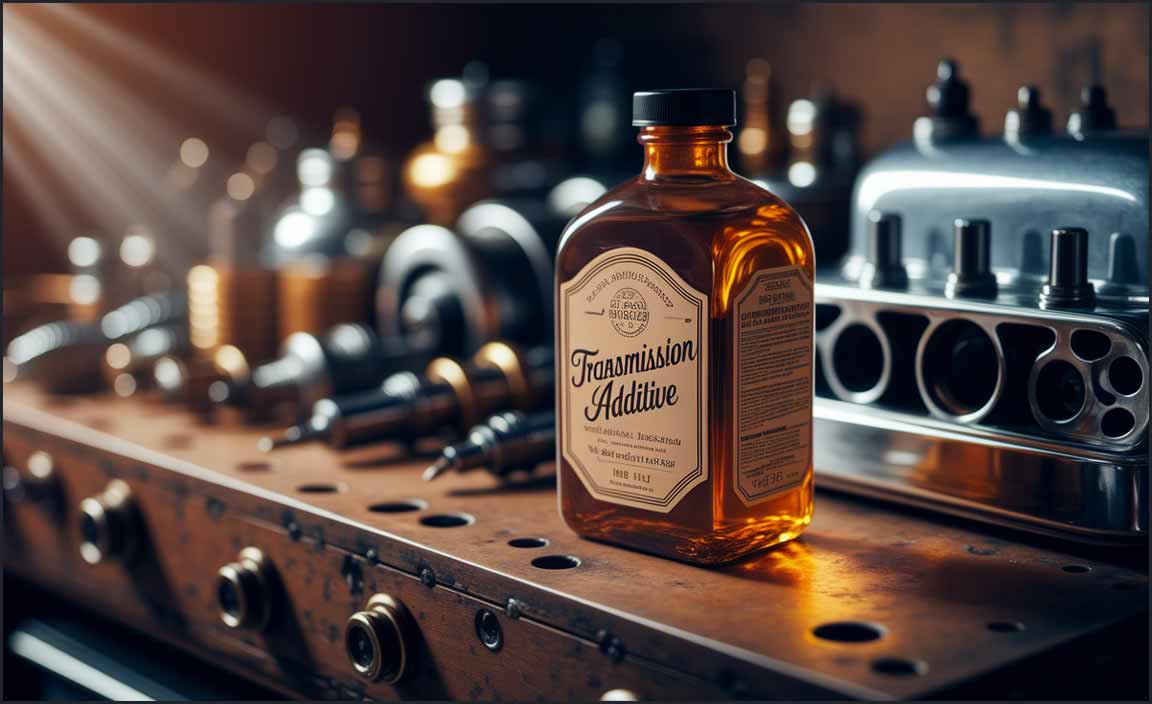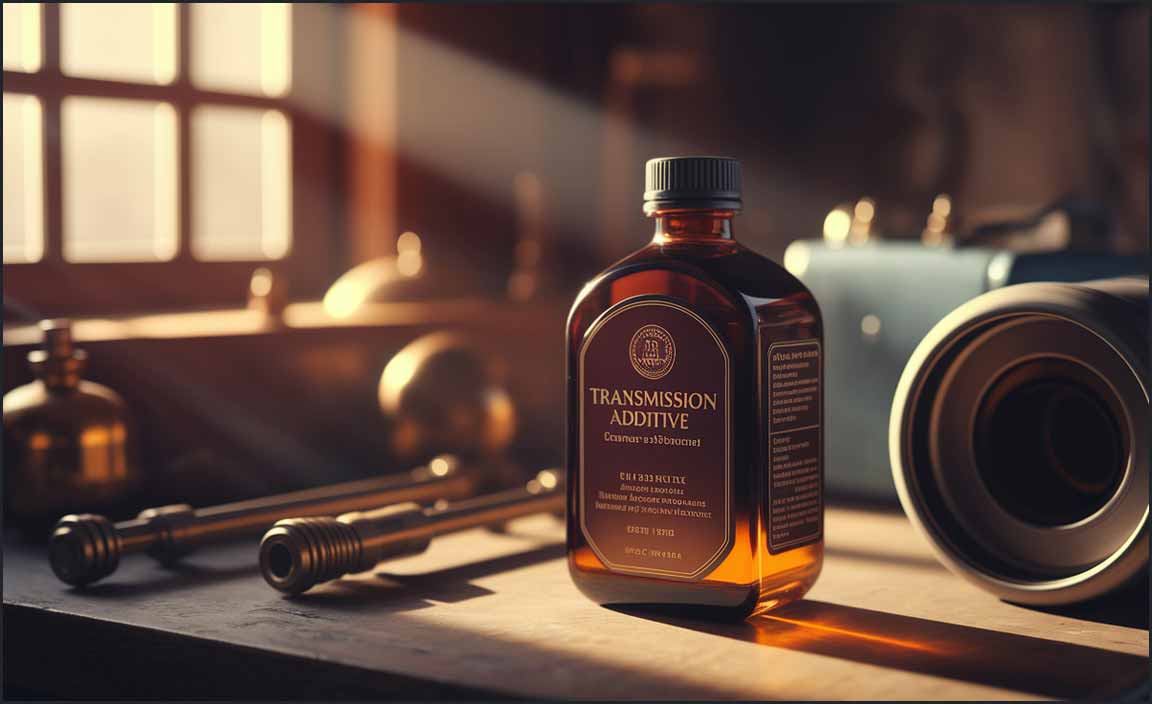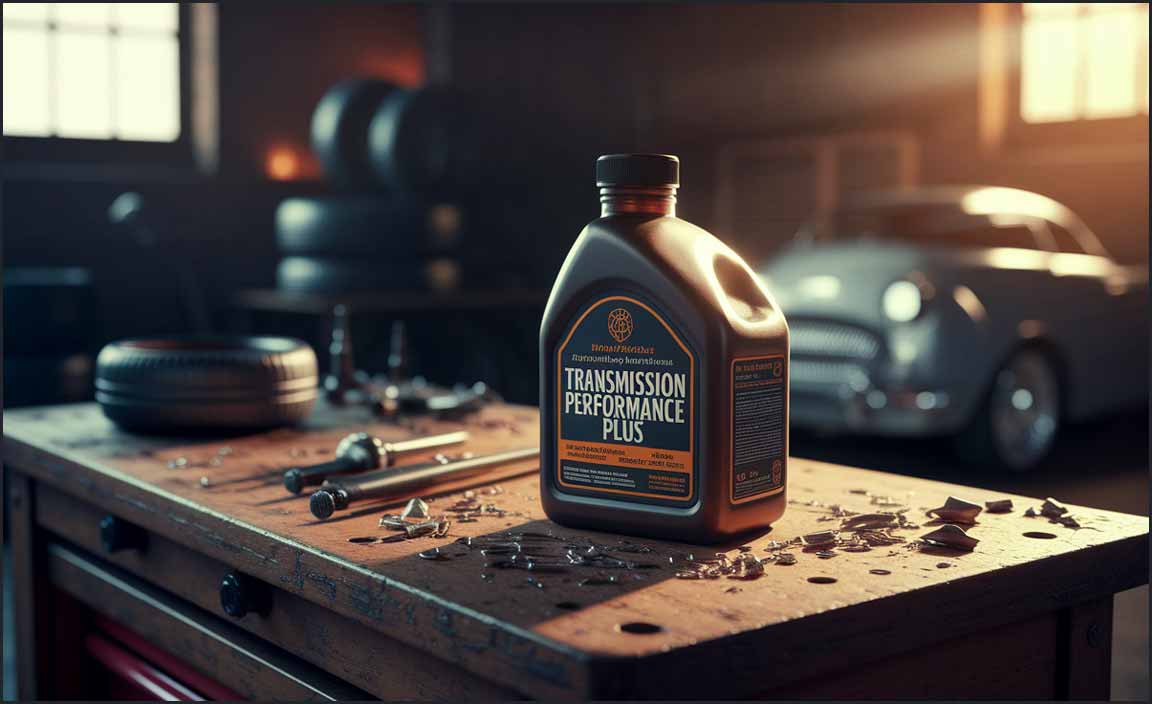Have you ever wondered how your car shifts gears? It’s like magic, but it’s not! The transmission makes it happen. Sometimes, transmissions need a little help. That’s where transmission additives come in. They can make your car run smoother. They might even help it last longer.
What if your bike chain was rusty? You’d oil it, right? Transmission additives are like oil for your car’s transmission. They help keep everything working well. Are they worth it? Let’s find out! These special liquids can do a lot. They can clean, protect, and improve how your car drives. But do you really need them? Keep reading to learn more about transmission additives.

Key Takeaways
- Transmission additives can improve shifting and reduce wear inside your car’s transmission.
- Using the right transmission additive can help extend the life of your transmission.
- Some additives help stop leaks and protect against rust and corrosion.
- It is important to choose an additive that is right for your car’s transmission type.
- Always follow the instructions on the additive bottle for the best results.
What Are Transmission Additives?
Transmission additives are special fluids. People add them to their car’s transmission fluid. They are designed to help the transmission work better. The transmission is a key part of your car. It helps transfer power from the engine to the wheels. This lets you go different speeds. Over time, the transmission fluid can break down. This can cause problems. These problems include rough shifting and overheating. Transmission additives can help fix these problems.

They can clean the transmission. They can lubricate its parts. Some even help stop leaks. Not all additives are the same. Some are for specific problems. Others are for general maintenance. It’s important to choose the right one for your car. Using the wrong additive could cause more harm than good. Always read the label and follow the directions. This will help keep your car running smoothly. It will also help extend the life of your transmission.
- Additives can clean the transmission.
- They lubricate moving parts.
- Some additives help stop leaks.
- Choose the right additive for your car.
- Always read and follow directions.
- Additives can help extend transmission life.
Think of your car’s transmission like a team of tiny helpers. These helpers work hard to shift gears. Over time, they get tired. The fluid they use gets dirty. Transmission additives are like giving those helpers a boost. They clean up the mess. They give the helpers new tools. This helps them do their job better. It can make your car shift smoother. It can also prevent big problems down the road. However, it’s important to pick the right additive. It is also important to use it correctly. Not all cars need the same help. Some cars might not need any help at all. Always check your car’s manual. Talk to a mechanic if you aren’t sure. This will help you keep your car running its best.
Fun Fact or Stat: Did you know that some transmission additives contain special polymers? These polymers help to improve the viscosity of the transmission fluid at high temperatures!
Why Use a Transmission Additive?
Have you ever seen a rusty bike chain? It’s hard to pedal, right? A car’s transmission is similar. It needs to be clean and well-lubricated to work right. Over time, transmission fluid can get dirty and break down. This can cause the transmission to work harder. It can also cause it to wear out faster. Transmission additives can help prevent this. They clean the transmission. They also add extra lubrication. This can make shifting smoother. It can also reduce wear and tear. Some additives also help protect against rust and corrosion. This is important, especially in older cars. Using an additive can be like giving your transmission a tune-up. It can help it run better. It can also help it last longer. But remember, not all additives are the same. Choose one that is right for your car and its needs.
When Should You Use One?
Imagine your favorite toy starts to slow down. You might change the batteries, right? Using transmission additives is similar. You might use them when you notice certain problems. Common signs include rough shifting. You might also hear strange noises. Leaks are another sign that something is wrong. If you see any of these signs, an additive might help. It can clean the system. It can also seal small leaks. It can improve the fluid’s performance. However, additives are not a fix-all solution. If the problem is serious, you might need to see a mechanic. They can diagnose the issue. They can also recommend the best course of action. Using an additive at the right time can prevent bigger problems. It can also extend the life of your transmission.
What Are the Benefits?
Think about wearing comfortable shoes. They make walking easier, right? Transmission additives offer several benefits for your car. They can improve shifting performance. They reduce wear and tear on parts. This can help the transmission last longer. Additives can also protect against rust and corrosion. This is important for older cars. Some additives help stop leaks. This can save you money on repairs. By keeping the transmission clean and well-lubricated, additives can improve its overall performance. This can lead to smoother driving. It can also help improve gas mileage. Always choose the right additive for your car. Follow the directions carefully. This will help you get the most out of the product. It will also ensure that you aren’t causing more harm than good.
Fun Fact or Stat: Some studies show that using transmission additives can improve fuel efficiency by up to 5%! This can save you money at the gas pump!
Types of Transmission Additives
Just like there are different types of shoes, there are different types of transmission additives. Some are designed for specific problems. Others are for general maintenance. One type is a sealant. This helps stop leaks. Another type is a friction modifier. This improves shifting. Some additives are cleaners. They remove dirt and deposits. There are also additives that protect against rust and corrosion. It’s important to know what your car needs.

Read the labels carefully. Choose the right additive for your car’s transmission type. Some cars need special additives. Using the wrong one can cause damage. If you aren’t sure, ask a mechanic. They can help you choose the right product. They can also make sure it’s used correctly. This will help keep your car running smoothly.
- Sealants stop leaks in the transmission.
- Friction modifiers improve shifting.
- Cleaners remove dirt and deposits.
- Some protect against rust and corrosion.
- Choose the right additive for your car.
- Ask a mechanic if you aren’t sure.
Imagine you’re baking a cake. You need the right ingredients, right? Choosing transmission additives is similar. You need to pick the right one for the job. Sealants are like patching a hole in a tire. They stop leaks. Friction modifiers are like adding oil to a squeaky door. They make things smoother. Cleaners are like washing your hands before you eat. They remove dirt and grime. Rust and corrosion inhibitors are like painting metal to protect it. They prevent damage. Knowing what each additive does helps you choose the right one. Always read the label carefully. Make sure it’s compatible with your car. If you’re not sure, ask a professional. This will help you avoid problems and keep your car running well.
| Additive Type | Purpose | Benefits | When to Use |
|---|---|---|---|
| Sealant | Stops leaks | Prevents fluid loss | When you notice leaks |
| Friction Modifier | Improves shifting | Smoother gear changes | Rough or hard shifting |
| Cleaner | Removes deposits | Improves fluid flow | Dirty transmission fluid |
| Corrosion Inhibitor | Protects against rust | Extends transmission life | Older cars or humid climates |
Fun Fact or Stat: Did you know that some transmission additives are made with synthetic materials? These materials can withstand higher temperatures and provide better protection!
Sealants: Stopping Leaks
Have you ever had a leaky water bottle? It makes a mess, right? A car’s transmission can leak too. This can cause problems. Sealants are transmission additives that help stop leaks. They work by swelling the seals inside the transmission. These seals can shrink or crack over time. This causes leaks. The sealant fills in these cracks. It makes the seals like new again. This stops the fluid from leaking out. Using a sealant can save you money. It can prevent costly repairs. It can also help keep your car running smoothly. If you notice a leak, a sealant might be the answer. Just be sure to choose one that is compatible with your car. Follow the directions carefully. This will help you get the best results.
Friction Modifiers: Improving Shifting
Imagine trying to run in shoes that are too sticky. It would be hard, right? A car’s transmission needs the right amount of friction. This helps it shift gears smoothly. Friction modifiers are transmission additives that help with this. They change the way the gears grip each other. This makes shifting easier. It can also reduce wear and tear on the transmission. If your car shifts roughly, a friction modifier might help. It can make the gears slide together more smoothly.
This can improve your driving experience. It can also help extend the life of your transmission. Just be sure to choose the right friction modifier for your car. Follow the directions carefully. This will help you get the best results.
Cleaners: Removing Deposits
Think about a dirty window. It’s hard to see through, right? A car’s transmission can get dirty too. Dirt and deposits can build up over time. This can cause problems. Cleaners are transmission additives that help remove these deposits. They work by dissolving the dirt and grime. This allows the fluid to flow more freely. It also helps the gears work better. Using a cleaner can improve your car’s performance. It can also help prevent bigger problems. If your transmission is sluggish, a cleaner might help. It can clean out the system. It can restore your car’s performance. Just be sure to choose a cleaner that is safe for your car. Follow the directions carefully. This will help you get the best results.
Fun Fact or Stat: Some high-performance cars use special transmission additives with advanced friction modifiers to improve shifting speed and accuracy on the racetrack!
How to Choose the Right Additive
Choosing the right transmission additive can seem tricky. But it’s not too hard if you know what to look for. First, check your car’s manual. It will tell you what kind of transmission fluid your car needs. Some additives are only for certain types of fluid. Using the wrong one can cause damage. Next, think about the problem you’re trying to solve. Do you have a leak?

Do your gears shift roughly? Are you just trying to maintain your transmission? Choose an additive that is designed for that specific problem. Read the labels carefully. Look for additives that are compatible with your car. If you’re not sure, ask a mechanic. They can help you choose the right product. They can also make sure it’s used correctly. This will help keep your car running smoothly.
- Check your car’s manual first.
- Match the additive to your fluid type.
- Choose an additive for your problem.
- Read labels carefully before buying.
- Ask a mechanic if you are unsure.
- Make sure the additive is compatible.
Imagine you’re buying a new phone case. You want one that fits your phone, right? Choosing transmission additives is similar. You need to find one that fits your car’s needs. Start by checking your car’s manual. This will tell you what type of fluid to use. Then, think about what you want the additive to do. Do you want to stop a leak? Do you want to improve shifting? Choose an additive that is designed for that purpose. Read the label carefully. Make sure it’s compatible with your car. If you’re not sure, ask a mechanic. They can give you advice. They can also help you choose the right product. This will help you keep your car running smoothly. It will also help you avoid problems.
Fun Fact or Stat: Some transmission additives are designed to work with specific car brands, like Ford or Honda. Always check the compatibility before using!
Read Your Car’s Manual
Have you ever tried to build something without instructions? It’s hard, right? Your car’s manual is like the instructions for your car. It tells you important things. It tells you what kind of transmission fluid to use. It also tells you about any special requirements. Before you choose an additive, read your manual. This will help you choose the right product. It will also help you avoid problems. Your manual knows what’s best for your car. It can guide you in the right direction. Ignoring your manual could lead to costly mistakes. So take the time to read it. It will help you keep your car running smoothly. It will also help you avoid damage.
Consider the Problem You’re Facing
Imagine you have a headache. You wouldn’t take medicine for a stomach ache, right? You need to choose the right medicine for the right problem. The same is true for transmission additives. Think about the problem you’re trying to solve. Is your transmission leaking? Is it shifting roughly? Is it making strange noises? Choose an additive that is designed for that specific problem. This will give you the best results. It will also help you avoid wasting money on the wrong product. If you’re not sure what the problem is, see a mechanic. They can diagnose the issue. They can also recommend the best course of action. This will help you keep your car running smoothly.
Read Product Labels Carefully
Think about buying a snack. You check the ingredients, right? You want to know what you’re eating. When choosing transmission additives, read the labels carefully. This will tell you what the additive does. It will also tell you if it’s compatible with your car. Look for additives that are designed for your car’s transmission type. Make sure it’s compatible with the fluid you’re using. Check for any warnings or precautions. Follow the directions carefully. This will help you get the best results. It will also help you avoid damage. Reading the label is an important step. It will help you choose the right product for your car.
Fun Fact or Stat: Some transmission additive labels include a QR code! You can scan it with your phone to get more information and see reviews!
How to Use Transmission Additives
Using transmission additives is usually pretty easy. But it’s important to do it right. First, make sure your car is parked on a level surface. Turn off the engine. Let it cool down. Find the transmission fluid dipstick. It’s usually marked with a symbol. Pull out the dipstick. Wipe it clean. Check the fluid level. If it’s low, you can add the additive. Pour the additive into the dipstick tube. Use a funnel to avoid spills. Add the amount recommended on the bottle.

Don’t add too much. This can cause problems. After adding the additive, check the fluid level again. Make sure it’s within the proper range. Start the engine. Let it run for a few minutes. This will help the additive circulate. Check for leaks. Take your car for a short drive. See if the shifting has improved. If you have any problems, see a mechanic.
- Park on a level surface.
- Turn off the engine to cool it down.
- Find the transmission fluid dipstick.
- Add the recommended amount of additive.
- Check the fluid level afterward.
- Start the engine and let it run.
- Take your car for a test drive.
Imagine you’re adding sugar to your lemonade. You don’t want to add too much, right? Adding transmission additives is similar. You need to add the right amount. Too much can cause problems. Start by finding the dipstick. This is how you check the fluid level. Add the amount of additive that is recommended on the bottle. Use a funnel to avoid spilling. After adding the additive, check the fluid level again. Make sure it’s not too high. Start the engine. Let it run for a few minutes. This will help the additive mix with the fluid. Take your car for a drive. See if it shifts better. If you have any problems, see a mechanic. They can help you diagnose the issue. They can also recommend the best course of action.
Fun Fact or Stat: Some transmission additives come in easy-pour bottles. These bottles make it easier to add the additive without spilling!
Finding the Transmission Fluid Dipstick
Have you ever looked for something and couldn’t find it? It can be frustrating, right? Finding the transmission fluid dipstick can be tricky. It’s usually under the hood. It’s often marked with a special symbol. This symbol is usually a gear or a wrench. Check your car’s manual for the exact location. The dipstick is usually a bright color. This makes it easier to spot. Once you find it, pull it out. Wipe it clean with a rag. This will help you get an accurate reading. If you can’t find the dipstick, ask a mechanic. They can show you where it is. They can also help you check your fluid level.
Adding the Correct Amount
Think about adding salt to your food. You don’t want to add too much, right? Adding transmission additives is similar. You need to add the correct amount. Too much can cause problems. Check the bottle for instructions. It will tell you how much to add. Use a funnel to avoid spilling. Pour the additive slowly. Check the fluid level as you go. Make sure it doesn’t go above the “full” line. If you add too much, you might need to drain some fluid. This can be messy. It’s better to add too little than too much. You can always add more later if needed. Following the directions carefully will help you avoid problems. It will also help you get the best results.
Checking for Leaks After Adding
Imagine you’re watering plants. You want to make sure the water goes where it’s supposed to, right? After adding transmission additives, check for leaks. Look under your car. See if you see any drips or puddles. Check around the transmission area. If you see any leaks, see a mechanic. They can fix the problem. Leaks can cause serious damage. They can also be dangerous. Catching them early can save you money. It can also prevent bigger problems. Checking for leaks is an important step. It will help you keep your car running safely and smoothly.
Fun Fact or Stat: Some transmission additives contain a dye. This dye makes it easier to spot leaks! Just use a UV light to see the dye.
Potential Problems with Additives
While transmission additives can help, they aren’t always the best solution. Sometimes, they can even cause problems. One problem is using the wrong additive. This can damage your transmission. Another problem is adding too much additive. This can also cause damage. Additives can also mask underlying problems. They might make your car run better for a while. But they won’t fix the real issue.

If you have a serious transmission problem, an additive might not be enough. You might need to see a mechanic. They can diagnose the problem. They can also recommend the best course of action. Using additives wisely can help. But it’s important to know their limitations. It’s also important to use them correctly.
- Using the wrong additive can hurt.
- Too much additive is not good.
- Additives hide bigger problems.
- Mechanics fix serious problems.
- Use additives wisely.
- Know what they can and can’t do.
Think about putting a bandage on a big cut. It might cover it up, but it doesn’t heal it, right? Transmission additives can be like that bandage. They might make your car run better for a while. But they don’t always fix the real problem. Using the wrong additive can even make things worse. It can damage your transmission. Adding too much additive can also cause problems. It’s important to use them wisely. If you have a serious transmission problem, see a mechanic. They can diagnose the issue. They can also recommend the best solution. Additives can be helpful. But they’re not a substitute for proper repairs.
Fun Fact or Stat: Some car manufacturers warn against using transmission additives. They say it can void your warranty!
Damaging the Transmission
Have you ever used the wrong tool for a job? It can break, right? Using the wrong transmission additive can damage your car. Some additives aren’t compatible. They can cause parts to wear out faster. They can also cause the fluid to break down. This can lead to serious problems. Always choose the right additive for your car. Read the labels carefully. If you’re not sure, ask a mechanic. Using the wrong additive can be costly. It can also shorten the life of your transmission. It’s better to be safe than sorry. Take the time to choose the right product. This will help you avoid damage.
Masking Underlying Problems
Think about putting makeup on a pimple. It covers it up, but it doesn’t make it go away, right? Transmission additives can mask underlying problems. They might make your car shift better for a while. But they don’t fix the real issue. The problem will still be there. It might even get worse over time. If you have a serious transmission problem, see a mechanic. They can diagnose the issue. They can also recommend the best solution. Don’t rely on additives to fix everything. They’re not a substitute for proper repairs.
Adding Too Much Additive
Imagine adding too much soap to your bubble bath. It gets too bubbly, right? Adding too much transmission additive can cause problems. It can change the fluid’s properties. This can affect how the transmission works. It can also damage the seals and other parts. Always follow the directions carefully. Add the amount recommended on the bottle. Don’t add more than you need. Too much additive can be harmful. It’s better to add too little than too much. You can always add more later if needed. This will help you avoid problems. It will also help you get the best results.
Fun Fact or Stat: Some transmission additives can cause the fluid to foam if you add too much! This can reduce its ability to lubricate and cool the transmission!
When to See a Mechanic Instead
Sometimes, transmission additives just aren’t enough. If you have a serious problem, you need to see a mechanic. Signs of a serious problem include slipping gears. This is when the car suddenly loses power. Another sign is loud noises. These noises can be grinding or clunking. Leaks can also be a sign of a serious problem. If you see a lot of fluid under your car, see a mechanic. If additives don’t fix the problem, see a mechanic. They can diagnose the issue. They can also recommend the best course of action. Ignoring a serious problem can lead to more damage. It can also be dangerous. It’s better to be safe than sorry. See a mechanic if you’re not sure what to do.
- Slipping gears are a bad sign.
- Loud noises mean trouble.
- Big leaks need fixing.
- Additives don’t always work.
- Mechanics can find problems.
- Ignoring problems is dangerous.
Imagine you have a broken bone. A bandage won’t fix it, right? You need to see a doctor. The same is true for serious transmission problems. Transmission additives might help a little. But they won’t fix a broken transmission. If you have slipping gears, loud noises, or big leaks, see a mechanic. They can diagnose the problem. They can also fix it properly. Ignoring a serious problem can make it worse. It can also be dangerous. It’s better to be safe than sorry. See a mechanic if you’re not sure what to do. They can help you keep your car running safely.
Fun Fact or Stat: Mechanics use special tools to diagnose transmission problems. These tools can help them find the source of the issue quickly and accurately!
Slipping Gears
Have you ever tried to climb a slippery slide? It’s hard to get anywhere, right? Slipping gears are similar. They mean your car isn’t getting power to the wheels. This can be dangerous. It can also be a sign of a serious problem. If your gears are slipping, see a mechanic. They can diagnose the issue. They can also fix it properly. Don’t try to fix it yourself. This can make the problem worse. Slipping gears need professional attention. They can be a sign of a worn-out transmission. They can also be a sign of low fluid. A mechanic can tell you what’s going on. They can also recommend the best course of action.
Loud Noises
Think about hearing a strange noise in your house. You’d want to find out what it is, right? Loud noises from your car’s transmission are a bad sign. They can mean something is broken. They can also mean something is loose. If you hear grinding, clunking, or whining noises, see a mechanic. They can diagnose the problem. They can also fix it properly. Don’t ignore loud noises. They can be a sign of a serious issue. They can also lead to more damage. A mechanic can tell you what’s going on. They can also recommend the best course of action.
Large Leaks
Imagine you have a leaky faucet. You’d want to fix it, right? Large leaks from your car’s transmission are a bad sign. They mean you’re losing fluid. This can damage your transmission. It can also be a fire hazard. If you see a lot of fluid under your car, see a mechanic. They can fix the leak. They can also check for other problems. Don’t ignore large leaks. They can lead to serious damage. They can also be dangerous. A mechanic can tell you what’s going on. They can also recommend the best course of action.
Fun Fact or Stat: Some mechanics use a special dye to find leaks. This dye glows under a black light. This makes it easier to see where the leak is coming from!
Summary
Transmission additives can be a helpful way to improve your car’s performance. They can clean, lubricate, and protect your transmission. They can also help stop leaks. However, it’s important to choose the right additive. You must also use it correctly. Not all cars need additives. Some additives can even cause problems. If you have a serious transmission problem, see a mechanic. They can diagnose the issue. They can also recommend the best course of action. Using additives wisely can help your car run smoothly. It can also extend the life of your transmission. But it’s not a substitute for proper maintenance and repairs.
Conclusion
Transmission additives can be useful for improving your car’s performance. They can help with shifting, reduce wear, and stop leaks. Always choose the right additive for your car. Follow the directions carefully. If you have serious problems, see a mechanic. Using transmission additives wisely can help keep your car running smoothly for longer.
Frequently Asked Questions
Question No 1: What exactly are transmission additives?
Answer: Transmission additives are special liquids you can add to your car’s transmission fluid. They’re like vitamins for your car! These additives help the transmission work better. They can clean the inside of the transmission. They can also protect the parts from wearing out. Some additives help stop leaks too. Think of them as giving your car a little boost to keep it running smoothly. It is very important to use the correct additive for your car model, as incorrect additives can cause damage.
Question No 2: How do I know if my car needs a transmission additive?
Answer: You might need a transmission additive if you notice some problems with your car. Does it shift gears roughly? Does it make strange noises when shifting? Do you see any leaks under your car? These can be signs that your transmission needs some help. Also, if your car has a lot of miles on it, an additive can help keep things running smoothly. It is like giving your car a little extra care as it gets older. If in doubt, it’s always a good idea to consult a mechanic.
Question No 3: Can transmission additives fix serious problems?
Answer: Transmission additives are good for small problems, but they can’t fix everything. Think of them like a band-aid. They can help with small cuts, but not with broken bones. If your car has serious problems, like gears slipping or loud clunking noises, you need to see a mechanic. Additives can sometimes hide problems for a little while. But they won’t fix the real issue. It’s best to get a professional to check it out. They can tell you what’s really going on.
Question No 4: Are all transmission additives the same?
Answer: No, not all transmission additives are the same! Some are made to stop leaks. Others are made to help with shifting. Some are just for cleaning. It’s like how there are different kinds of medicine for different sicknesses. You need to choose the right additive for your car’s problem. Read the labels carefully. Make sure the additive is safe for your car. If you’re not sure, ask a mechanic. They can help you pick the right one. Using the wrong additive could make things worse.
Question No 5: How often should I use a transmission additive?
Answer: You don’t need to use transmission additives all the time. Only use them when you notice a problem or as part of regular maintenance. Some people use them every time they change their transmission fluid. Others only use them when they see signs of trouble. It depends on your car and how you drive. Check your car’s manual for recommendations. Don’t use additives too often. It could cause problems. Always follow the directions on the bottle. Also, remember to check if the additive is compatible with your specific car.
Question No 6: Can I add a transmission additive myself?
Answer: Yes, you can usually add a transmission additive yourself. It’s not too hard. First, find the transmission fluid dipstick. It’s usually under the hood. Then, pour the additive into the dipstick tube. Use a funnel to avoid spilling. Make sure you add the right amount. Check the fluid level after you add the additive. If you’re not comfortable doing it yourself, ask a mechanic. They can add it for you. They can also check your transmission to make sure everything is okay. Always be careful when working with car fluids.